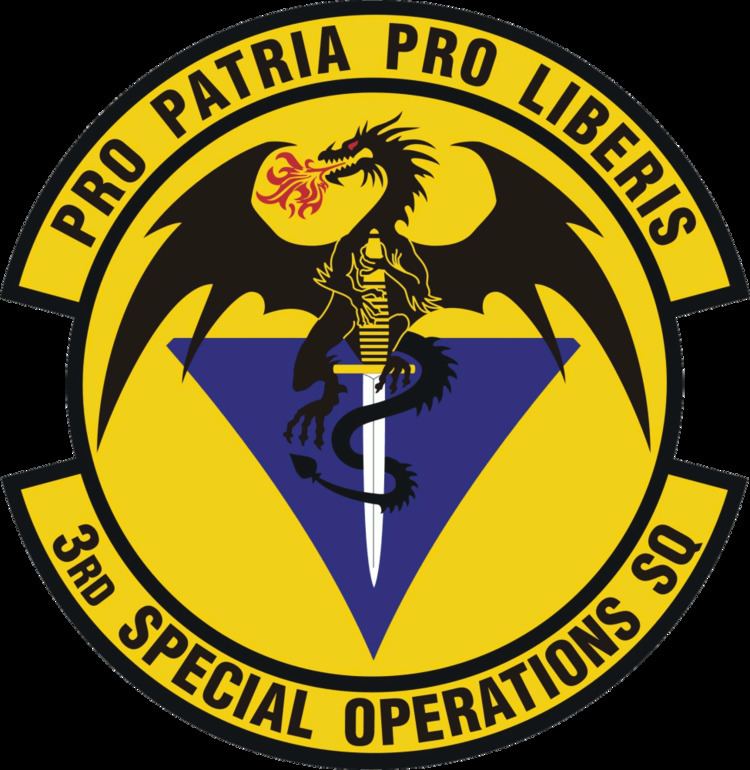Active 19??-Present Garrison/HQ Cannon AFB, New Mexico | Country United States | |
 | ||
Branch United States Air Force Part of Air Force Special Operations Command | ||
The 3d Special Operations Squadron (3 SOS) flies MQ-1 Predator Remotely Piloted Aircraft (RPA) and is currently located at Cannon Air Force Base in Clovis, New Mexico. The 3d SOS is under the command of the Air Force Special Operations Command.
Contents
Mission
Currently operates Predators engaged in Freedom Sentinel.
History
Organized in France in April 1918, the Photographic Section No. 1 processed aerial photographs taken by flying units working with the I Army Corps (American) and French XXXVIII Army Corps, 5 April–November 1918. The 1 Photographic Section, from September 1919 until becoming the 3 Observation Squadron on 1 June 1937, processed aerial photography of associated observation squadrons in Texas.
At Langley Field, VA, the squadron engaged in aerial observation work with the Coast Artillery School until April 1942. It supported ground forces on maneuvers during 1942, and served as a training and demonstration unit January 1943 – February 1944. The squadron was not manned or equipped, 1 Mar – 2 July 1944.
Activated again in May 1952 under Strategic Air Command as part of its global reconnaissance mission. The squadron did not receive its first aircraft until 1 July 1953, when it immediately began familiarization training, followed by in-flight refueling training in February 1954. It received RB-47E aircraft in March 1954, and conducted its first long-range mission (6 planes to Alaska for 10 days) in May 1954. The squadron deployed at RAF Upper Heyford, England, 14 September – 3 November 1954. Some of these flights were mounted from Thule in Greenland and probed deep into the heart of the Soviet Union, taking a photographic and radar recording of the route attacking SAC bombers would follow to reach their targets. Flights which involved penetrating mainland Russia were termed SENSINT (Sensitive Intelligence) missions. One RB-47 even managed to fly 450 miles inland and photograph the city of Igarka in Siberia. It photographed numerous Air Force bases and American cities, 1954–1958, and participated regularly in SAC exercises. Missions flown on a reduced scale after February 1958 when events showed the vulnerability of the RB-47 to Soviet air defenses and the development of the U-2 aircraft. Became non-operational, 15 April – 1 July 1958. when it inactivated.
As the 3d Air Commando Squadron in South Vietnam, it absorbed resources of the 14 Air Commando Squadron. It flew combat missions in AC-47D gunships in close air support of ground forces, providing flare illumination and gunfire in support of strategic hamlets, out¬posts, and friendly forces under night attack. From 16 February – 1 May 1969, all squadron aircraft were maintained on ground alert when not flying, due to the TET (New Year) offensive. It began transferring its gunships to the Vietnamese Air Force in June 1969 and flew its last mission on 7 August 1969.
The 3 Tactical Electronic Warfare Training Squadron although having a "tactical" designation, was not equipped with aircraft. Rather, it operated Camp O'Donnell, Philippines, the Pacific Air Forces Electronic Warfare Range, the Crowe Valley Aerial Gunnery Range, and associated facilities. It provided realistic conventional, tactical, and electronic warfare training in a simulated combat environment during COPE THUNDER exercises. These exercises provided combat training for fighter aircrews of not only the US Air Force, but also fighter crews of the US Marine Corps, US Navy, and allied air forces in the western Pacific area. Following the eruption of Mt Pinatubo in June 1991, personnel were evacuated, and the squadron remained unmanned until its inactivation.
Provided remotely piloted aircraft (RPA) support to a multitude of ground forces, 2005 – present.
